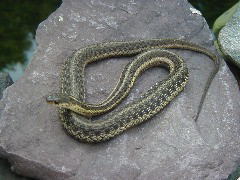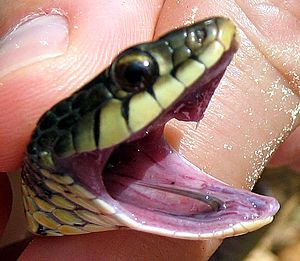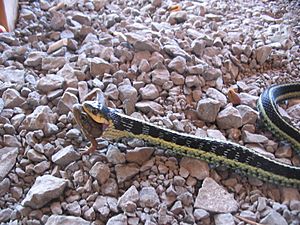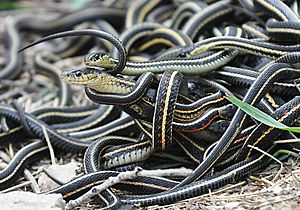Garter snake facts for kids
Garter snakes are small to medium-sized snakes that are mostly harmless to humans. They are also known by names like garden snake, gardener snake, and ribbon snake. These snakes belong to a group called Thamnophis.
Garter snakes live only in North America. You can find them from the cold northern parts of Canada all the way down to Central America. The common garter snake is even the official state reptile of Massachusetts.
Contents
Where Garter Snakes Live
Garter snakes live in many parts of North America. They can be found in many different places because they eat various foods and can adapt to different homes.
You might find them in forests, woodlands, fields, grasslands, and even your lawn. However, they are always close to water, like a wetland, stream, or pond. This is because they love to eat amphibians, which live near water.
How Garter Snakes Behave
Garter snakes use special smells called pheromones to talk to each other. They can follow trails left by other snakes just by their scent. Male and female snakes have very different smells.
Sometimes, male garter snakes can even make both male and female smells! During mating season, this trick makes other males try to mate with them. This helps the male snake get warmer, which is useful right after they wake up from their winter sleep. Snakes that do this often get to mate more than other males.
Garter snakes use their tongues to pick up chemical smells from the air. These smells go to a special organ called the Jacobson's organ. This helps them understand their surroundings and communicate.
If a garter snake feels bothered, it might coil up and try to strike. But usually, it will hide its head and wave its tail around. They can also release a stinky, musky liquid from a gland near their tail. These tricks help them escape from animals that want to eat them. They might also slither into water to get away from danger on land.
Many animals eat garter snakes. These include birds of prey, crows, egrets, herons, cranes, raccoons, otters, and other snakes like the coral snake and king snake. Even tiny shrews and frogs will eat baby garter snakes.
Like all reptiles, garter snakes are cold-blooded. This means they need to warm up in the sun to control their body temperature. In winter, garter snakes gather in large groups in special dens called hibernacula. They might travel long distances to reach these winter homes.
What Garter Snakes Eat
Garter snakes are carnivores, meaning they only eat meat. They will eat almost any creature they can catch. Their diet includes slugs, earthworms, leeches, lizards, amphibians (like frogs and their eggs), small fish, and rodents.
If they live near water, they will eat other water animals. The ribbon snake especially likes frogs and tadpoles, even if the frogs have strong chemical defenses. Garter snakes swallow their food whole. They are good at eating whatever food they can find, whether there's a lot or a little. Sometimes, they even eat eggs.
Garter Snake Venom
For a long time, people thought garter snakes were not venomous at all. But scientists recently found out that they do make a mild venom. However, this venom is not strong enough to hurt humans, and garter snakes cannot deliver it effectively.
They have slightly larger teeth at the back of their mouths, but their gums are too big to properly inject venom. The liquid they produce is only a little bit toxic.
Scientists have found that garter snakes and newts (a type of amphibian) have a shared history. They both have developed ways to deal with a toxin called tetrodotoxin (TTX). This suggests they have evolved together, with each adapting to the other.
Garter Snake Reproduction
Before garter snakes mate, they go into a winter sleep called brumation. About two weeks before this, they stop eating to make sure their stomachs are empty.
Garter snakes start mating as soon as they wake up from brumation. Males often wake up first in colder areas, giving them time to get ready. When females start to appear, males gather around them. Female garter snakes release a special smell that attracts many males. This can lead to "mating balls" where up to 25 males surround one female!
After mating, the female leaves the den to find food and a safe place to give birth. Female garter snakes can store the male's sperm for years before using it to fertilize eggs. The babies grow inside the mother's lower belly.
Garter snakes give birth to live young. This is called ovoviviparous. It's different from mammals, which are truly viviparous. The babies grow for about two to three months. A single mother can have anywhere from 3 to 80 babies at once. The most babies ever recorded in one litter was 98! The young snakes are ready to live on their own as soon as they are born.
Garter Snake Conservation
Even though garter snake numbers have gone down in some places, they are still very common reptiles. Their populations have been affected by people collecting them as pets, pollution in water areas, and new predators like bullfrogs.
However, one type of garter snake, the San Francisco garter snake (Thamnophis sirtalis tetrataenia), is in danger. It has been on the endangered list since 1969. Another type, the narrow-headed garter snake, has seen its numbers drop because of crayfish eating them.
Garter Snakes as Pets
Some types of garter snakes are popular pets, like the Common garter snake (T. sirtalis), Checkered garter snake (T. marcianus), and Ribbon snake (T. sauritus).
Baby garter snakes shed their first skin almost right after they are born and start eating soon after. A 10-gallon (38 liter) tank is usually enough for them. Feeding baby garter snakes can be a bit tricky. They can eat earthworms, night crawlers, small fish like silversides, or cut-up pieces of thawed pinky mice. It might take up to 10 days for a baby garter snake to start eating in a new home.
Images for kids
Related pages
See also
 In Spanish: Thamnophis para niños
In Spanish: Thamnophis para niños











